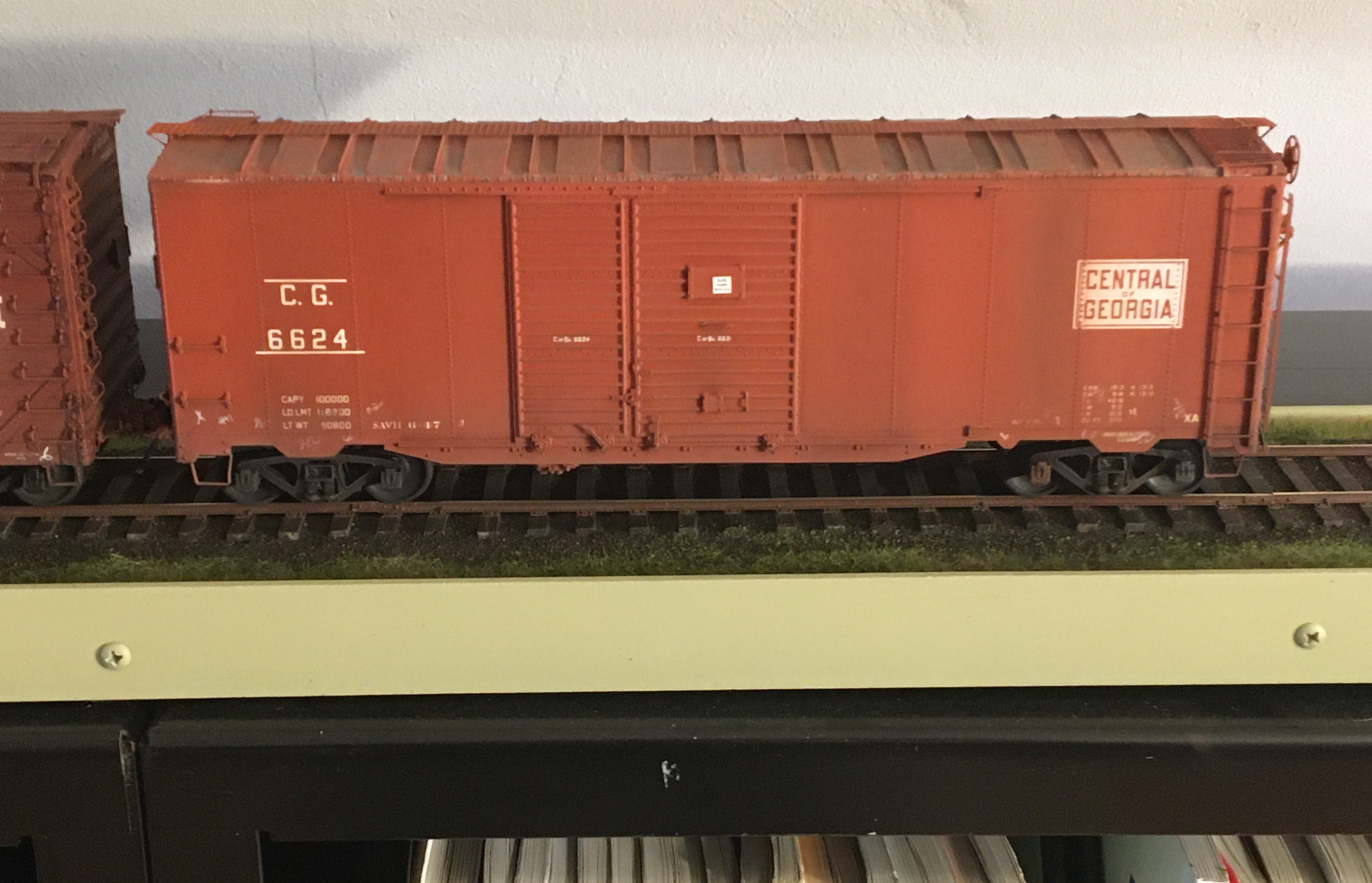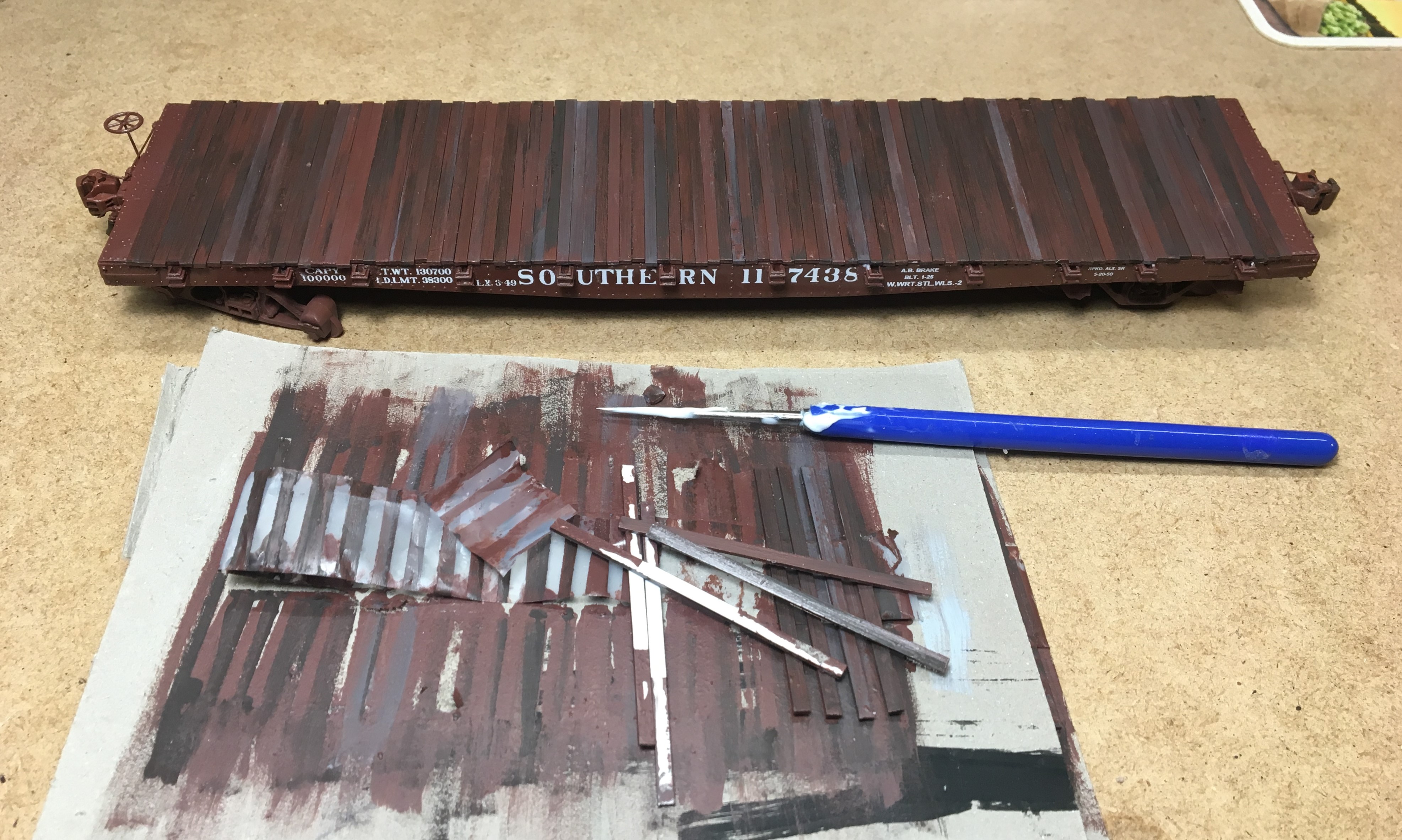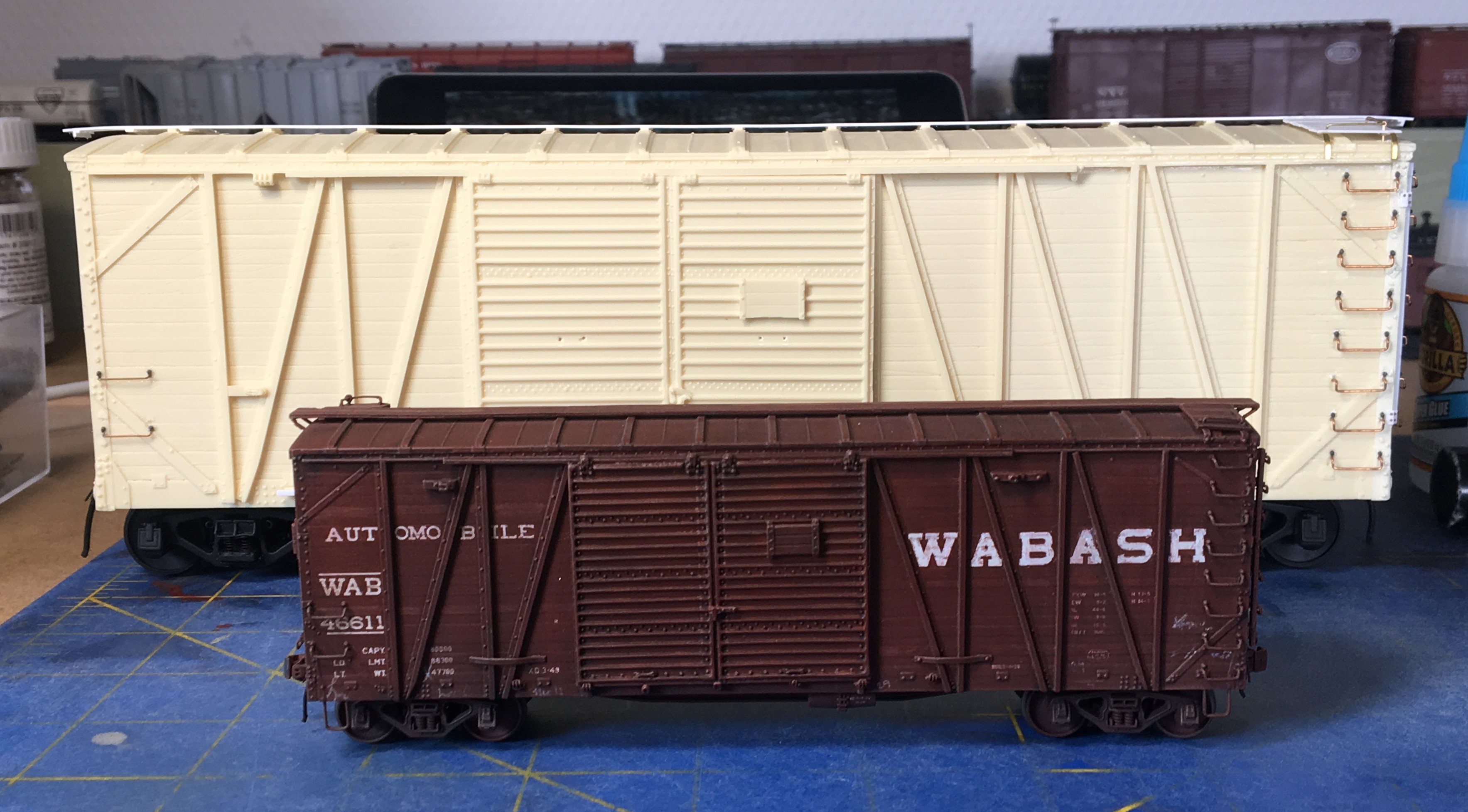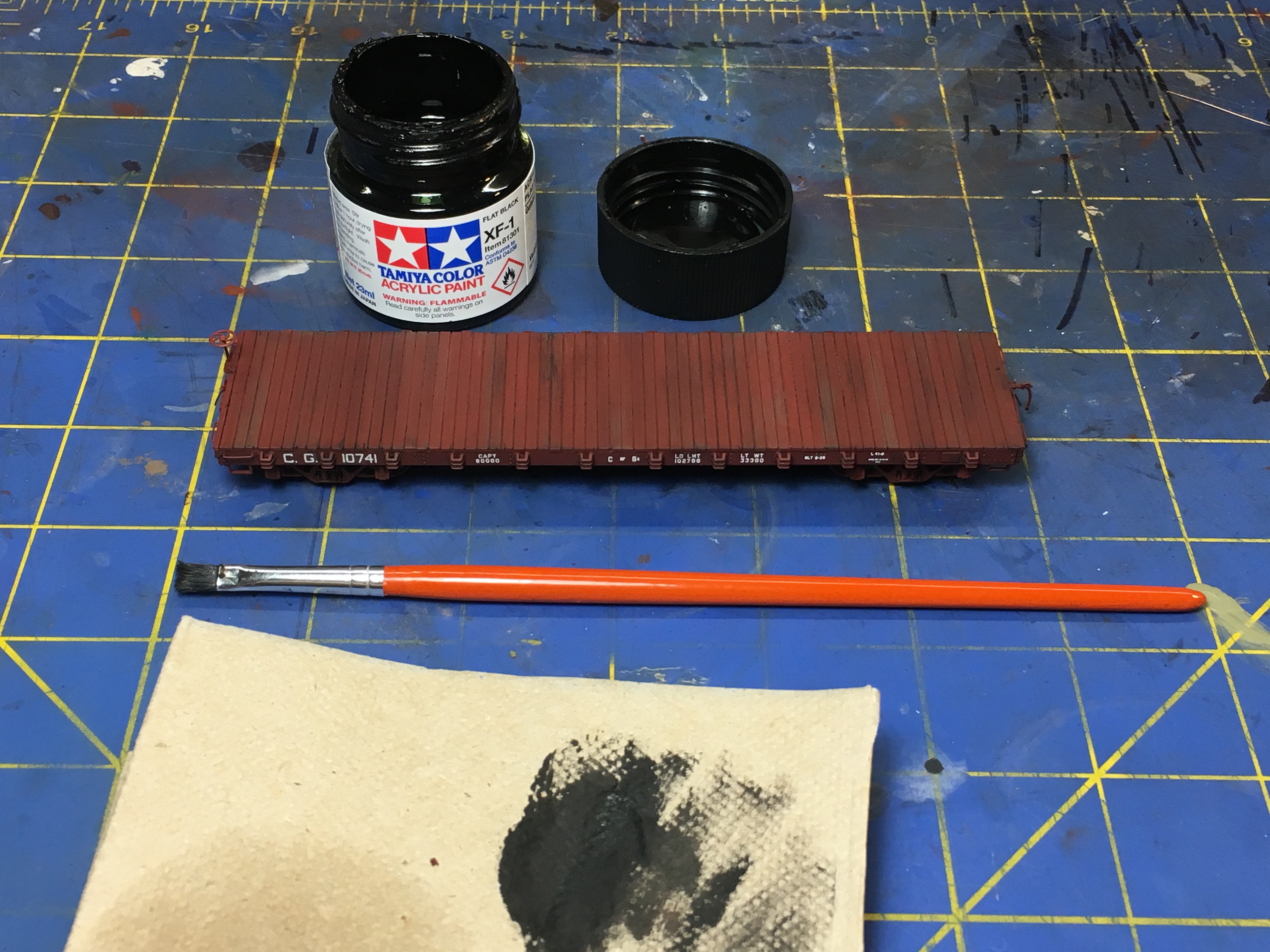
Years ago I had dinner with Ted Schnepf. Ted is a former Milwaukee Road track guy and now runs an online and traveling hobby shop called Rails Unlimited (http://railsunlimited.ribbonrail.com/). I explained to Ted that I had an HO layout and was fully-invested in HO scale, but I also enjoy building Proto48 freight car models as a side-hobby.
Ted said, “Oh yeah, you’re what we call a rubber-gauger. That’s a guy that bounces back and forth between a few scales.”
New Proto48 Builds
I’ve lived back in the St. Louis area for a little over four months now, and in that time I’ve focused on building many of the models stashed away in my “someday” box. Included in the someday box is about 15 O scale freight car kits of various types. I’ve built up three of them in the last two months. Here’s a report.
New York Central USRA Hopper
After knocking out 13 HO scale cars this fall I began the build on an Oscale Intermountain USRA hopper kit. It’s a beautiful kit–simple, nicely-detailed and BIG. The prototype for my car is below. Photo courtesy Jay Williams.

I started with the ends on this model. The ends are applied as one piece, which saves a lot of time, but I replaced the plastic grabs with brass and had to bend all the grabs myself.

Below. Here’s an in-progress shot of the ends. The ends are taped on awaiting glue to dry, and I’m adding grabs one by one. The next photo shows some of the work completed. I must say, the work is exactly the same as in HO, but completely different because of the size and the scope of work. I think this experience will help my HO scale building in the future.

I am modeling a modernized car and installed AB brakes on the model. The installation took three or four hours for the brakes alone. I know how to do it now, so I should be able to do it in half the time for the next car.
The coupler face plate was made from styrene and based on a few photos from rebuilt NYC cars. The trucks are San Juan Proto48 Andrews trucks, which have a beautiful cross-section but take yet another hour to build. The wheelsets are by Protocraft–they are exactly 4 ft, 8-1/2 in, not 5 ft, 0 in like standard O scale.

More to follow on this model as it gets sandblasted, painted and decaled. I’m really looking forward to finishing it.
PFE R-40-10
The second car I built up was this Intermountain PFE steel refrigerator car. This is another beautiful Intermountain model from the mid-1980s. The build is straight-forward, but I added replacement brake gear from San Juan, wire grabs, brass air hoses, and a few other details all around.

Below. Here’s my AB brake gear install. I used the San Juan AB brake set, scale chain, a bunch of wire parts, and some leftovers from the Intermountain kit. The trucks are Proto87 scale ARA trucks from Protocraft.

Below. Here’s another completed car view. I made my own running boards from Evergreen styrene, scaled out to 2 x 6 in 1-48 scale. I will model this car with hatches open. I like the variety of having a car here and there with the hatches open, although cars infrequently moved in that configuration. All the detail parts like the hinges, grabs, door locks, and etc. are taped to a piece of cereal box, ready to be painted.

Here’s the prototype for my model, the R-40-10 with Southern Pacific monogram, circa late 1940s. Bob’s Photo. I’m looking forward to having this car done too, and then building up a companion car.

Type 27 Tank Car
This is the O scale car I’m most excited about. I bought it online a few months ago and honestly this is the model that motivated this latest O scale building binge. It’s an ancient Intermountain Type 27 8,000-gal tank car that’s probably been in the box since 1985. I’ve wanted to build a few O scale tank cars for years. There are very few higher-quality O scale tank cars on the market and this one will build up into a beautiful model with a few aftermarket parts and a good paint job.

Here’s a near dead-on prototype for the Intermountain model, below. SHPX 20585 is about as plain-jane as Type 27 cars got. This is a simple petroleum-service car with all the brake components on the same side. The only difference I can discern is the heater pipes, which the Intermountain model doesn’t have. Photo courtesy Pat Wider.

Below. I started the project by building up the underframe and adding aftermarket brake gear. The brake gear set used is the outstanding kit made by San Juan. Interestingly it is cheaper that it’s best HO scale counterpart–the Cal Scale No. 293–but the San Juan kit is infinitely better detailed. An important aftermarket part missing in both HO and O scale is brake hangars; I used brass wire to simulate them as I do when installing HO brake gear.

The SHPX car being modeling had the valve installed above the cylinder. I studied drawings sent to me by Norm Buckhart at Protocraft and a few guys on the Steam Freight Cars list. Later production cars had the valve and cylinder on opposite sides of the center sill.

Below. Here’s the completed underframe with the brake rigging, trucks and additional details installed. Detailing up to this point was fun, and exhausting, and satisfying.

In addition to the brake gear work, the model needs a few additional upgrades to “robustify” it. One of those upgrades is improving the additional tank bands included in the kit. The kit parts just don’t cut it, so I made my own bands and added brass wire and Grandt Line turnbuckles to improve the detail.

Once all four replacement tank bands were in place, I was able to fix the tank body to the frame. Everything looks alright so far. By the way, the trucks I’m using are Protocraft 50-ton Coil-Elliptical freight trucks, which can be found at https://www.protocraft.com/category.cfm?ItemID=10378&Categoryid=31. Few SHPX 8,000-gallon cars had these trucks.

Another item I had to scratchbuild was new side ladders. I made mine out of brass strip and wire I had on hand. First I taped the replacement ladder styles on the workbench using the ladder that came with the kit as a guide. Next, I marked and drilled holes to install the rungs.

Below. I made a little jig to hold the ladder so I could solder the rungs in position.

A whole lot of amateur soldering work later, I came up with this. I soldered the rungs to the stiles, and also had to solder an additional strip to the styles to I could bend them around the handrail. I’d like to build at least one more of these models and if I can improve my soldering skills I’ll make up a few replacements for this car.

And finally, there is this car, a 1958 cu. ft. ACF covered hopper. I didn’t build it–it’s an Overland brass model that I bought unpainted. I wanted to finish it as a Seaboard Air Line car, but after a little research I found it didn’t match any SAL prototypes. I scoured the RP Cycs looking for a prototype and only came up with two–Southern Pacific and Milwaukee Road. I asked Mike at K4 decals to modify his HO scale covered hopper set so it included the “Complex Tilted Box” monogram and will finish the model as an as-delivered CMStP&P car soon.

Someday in my retirement I’d like to build a Proto48 shelf switching layout. That day is coming pretty fast. When that day comes I’ll have plenty of freight cars ready for action.
I pray you will have God’s Blessing in 2023! – John G






























































































































 Above. This is a Sunshine M&StL box car, one of three that will run on the railroad. The build on this model was started last November and it was completed tonight. I have two more of these models; one is complete and one is already built-up and is awaiting a trip into the sandblaster. The first car I built has some construction problems that were able to be corrected in the latter two cars.
Above. This is a Sunshine M&StL box car, one of three that will run on the railroad. The build on this model was started last November and it was completed tonight. I have two more of these models; one is complete and one is already built-up and is awaiting a trip into the sandblaster. The first car I built has some construction problems that were able to be corrected in the latter two cars.



